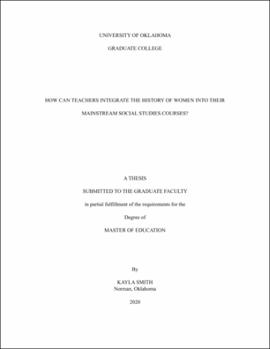| dc.contributor.advisor | Houser, Neil | |
| dc.contributor.author | Smith, Kayla | |
| dc.date.accessioned | 2020-05-11T15:03:37Z | |
| dc.date.available | 2020-05-11T15:03:37Z | |
| dc.date.issued | 2020-05-08 | |
| dc.identifier.uri | https://hdl.handle.net/11244/324372 | |
| dc.description.abstract | Women are often underrepresented in traditional social studies courses. In this qualitative study I sought to understand how current teachers were integrating the history of women into their mainstream social studies courses. I interviewed five teachers who were recognized as being inclusive of women in their social studies curriculum. Four instructional methods prevailed. They were creating student engagement, using primary documents, encouraging collaboration, and creating safe environments. Using Parker Palmer’s A Courage to Teach (2017) as a theoretical framework, I concluded that although the teachers’ instructional methods and curriculum choices were important, the reasoning behind their curriculum choices and methods and the inner selves of the teachers were also instrumental in the creation of balanced classroom experiences. This study lends support to the idea that educators should seek within themselves to reach beyond traditional avenues of teaching and create classroom environments that are equal to and reflective of all of our students’ identities. | en_US |
| dc.language | en_US | en_US |
| dc.subject | Education | en_US |
| dc.subject | social studies | en_US |
| dc.subject | Women's History | en_US |
| dc.subject | inclusion | en_US |
| dc.title | HOW CAN TEACHERS INTEGRATE THE HISTORY OF WOMEN INTO THEIR MAINSTREAM SOCIAL STUDIES COURSES? | en_US |
| dc.contributor.committeeMember | Reeder, Stacy | |
| dc.contributor.committeeMember | Brugar, Kristy | |
| dc.date.manuscript | 2020-05-01 | |
| dc.thesis.degree | Master of Education | en_US |
| ou.group | Jeannine Rainbolt College of Education::Department of Instructional Leadership and Academic Curriculum | en_US |
| shareok.nativefileaccess | restricted | en_US |
